Not sure how to spend a short layover at Haneda Airport? This guide covers everything you need to make the most of your limited time—from dining and relaxation to cultural experiences and essential services, both within the airport and nearby. Created by a Tokyo-based tour company that specializes in helping international visitors explore Japan, this article offers clear, reliable advice tailored for transit travelers.
Tokyo Travel Assist offers a Haneda Layover tour.
If you have a long layover of more than 9 hours, we recommend reading the “Haneda Long Layover Guide” first.
Table of Contents
ToggleWondering where to rest, shower, or sleep during a layover at Haneda Airport?
To shower: 24-hour shower rooms are available outside the security area in Terminal3
To sleep : The Royal Park Hotel is located within Terminal 3. The hotel also features refresh rooms, available by the hour, which include a private shower booth, sofa, and TV, but no bed.
A separate branch of the same hotel is also available inside the transit area
What You Can Do Inside the Transit Area at Haneda Airport
If you’re visiting Haneda Airport for the first time and have a layover without entering Japan, it’s important to know what each terminal offers inside the transit (airside) area.
Terminal 3 – Best Equipped for International Transit Travelers
Terminal 3 is convenient for international travelers staying in the transit area. Without passing through immigration, you’ll find:
• Duty-Free Shops: High-end luxury brands, Japanese souvenir stores, and even UNIQLO
• Shops: Convenience stores, bookstores, and drugstores for essentials
• Restaurants: 12 dining options offering both Japanese and international cuisine
• Hotel: A transit hotel is available for short stays
Terminal 3 offers a wider range of options for shopping, dining, and relaxing.
Terminal 2 – Limited Facilities for Transit Passengers
Terminal 2 is mainly used for domestic flights, and if you’re transiting here without entering Japan,
Be aware that the transit area has only a few duty-free stores, limited shopping options, and a small food court.
Unless your connecting flight is soon, it is recommended to go through immigration and spend your layover in the public areas, where lounges, shops, and dining options are available.
Getting Around Between Terminals
Haneda Airport provides convenient options for getting between terminals. The most practical method is the free terminal shuttle bus, which runs every five minutes and connects all terminals efficiently.
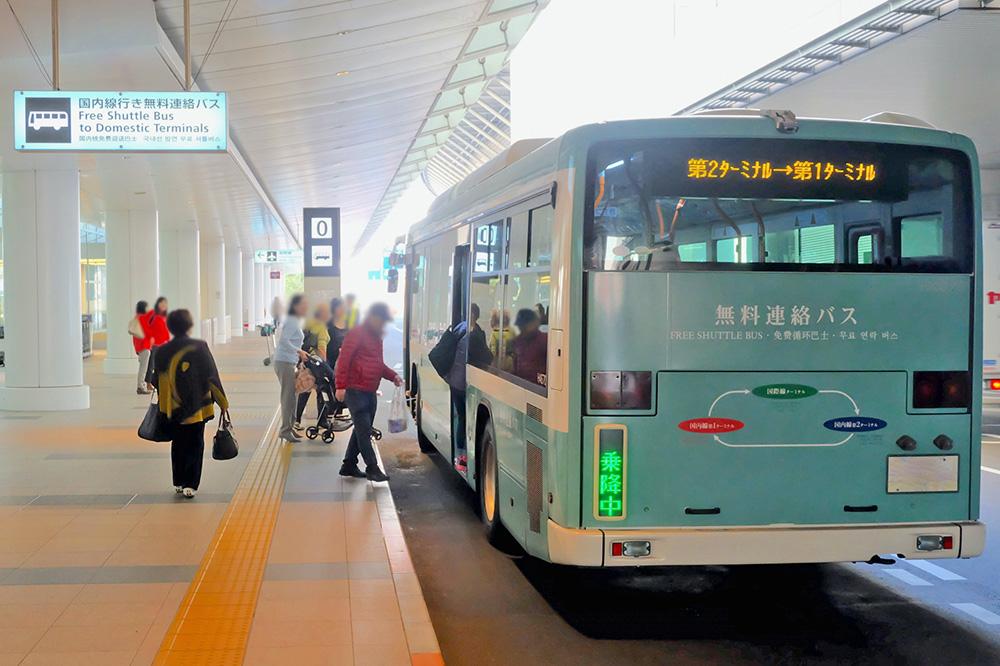
Travelers can also use the Keikyu Line or Tokyo Monorail to move between terminals, especially when carrying luggage or heading to a specific train connection.
While walking between Terminal 1 and Terminal 2 is possible via an indoor passageway next to the Keikyu Line ticket gates, walking from Terminal 3 to the other terminals is not allowed due to restricted access areas and distance. In such cases, the shuttle bus or train is recommended.
For more details, please refer to Haneda Airport’s Travel Between Terminals.
Enjoy a Variety of Foods
Sampling local cuisine can be one of the most enjoyable parts of any trip, and Haneda Airport offers a variety of comforting, flavorful dishes that are easy to enjoy during a layover.
Here are some recommended dining options available in each terminal.
Terminal3
The restaurants listed below are all outside the security area.
GINZA OGURA
GINZA OGURA brings a taste of one of Ginza’s famous restaurants to Haneda Airport. Known for its oden and dashi chazuke, it offers a comforting experience of authentic Japanese flavors.
Oden is a traditional Japanese stew made with a variety of ingredients like boiled eggs, tofu, daikon radish, and fish cakes, all simmered in a savory broth. The dish is perfect for those seeking a warm, flavorful meal.
Dashi chazuke, on the other hand, is a simple yet satisfying dish made by pouring warm dashi (a broth made from dried bonito flakes and kombu seaweed) over a bowl of rice. It’s often served with pickled vegetables or grilled fish, making it a light but nourishing option.
TSURUTONTAN
TRUSUTONTAN is a well-known Japanese udon restaurant famous for its refined take on this everyday comfort food.
Udon is a type of thick wheat noodle served in a variety of hot or cold broths, often topped with ingredients such as tempura, sliced beef, or seasonal vegetables. Its smooth texture and mild flavor make it an easy introduction to Japanese cuisine.
One unique feature of TRUSUTONTAN is its portion flexibility—diners can enjoy up to three servings of noodles at no extra cost, making it a great choice for travelers with a big appetite or those simply curious to try more.
DiversityDiner HND
For those seeking vegan or plant-based options, DiversityDiner HND in Terminal 3 offers a modern interpretation of Japanese cuisine, crafted entirely without animal products.
The menu excludes meat, seafood, refined sugar, five pungent roots (such as garlic and onion), and chemical seasonings—making it suitable for a wide range of dietary needs, including vegan, vegetarian, halal, and oriental vegan preferences.
The restaurant is supervised by chef Katsuzo Kusumoto, who also leads Saido, a Tokyo-based vegan restaurant that earned the top spot on HappyCow’s global ranking of the “Best Vegan Restaurants in the World.” Desserts are created under the guidance of award-winning pastry chef Hironobu Tsujiguchi, known internationally for his refined, artful creations.
Even those with halal, vegan, or oriental vegan dietary preferences can appreciate the colorful presentation of the food.
Terminal2
The restaurants listed below are all outside the security area.
NUMAZU UOGASHIZUSHI
Numazu Uogashi Sushi offers a variety of seafood dishes featuring exceptionally fresh fish delivered directly from Numazu, a top fishing port in Suruga Bay. Alongside sushi prepared in the Edomae style, the restaurant also serves a range of small plates made with specialty ingredients from different parts of Shizuoka Prefecture.
Guests can enjoy regional flavors not only through the food, but also through a curated selection of locally brewed sake, well-known across Shizuoka. The menu highlights the richness of the area’s culinary culture, making it a great choice for travelers interested in trying both sushi and other regional Japanese dishes.
Tenmasa
Tenmasa is a long-standing tempura restaurant founded in 1937, known for its tradition of preparing tempura right in front of guests. Each piece is lightly battered and fried to order, offering a crisp texture and delicate flavor that highlights the freshness of the ingredients. Tempura typically includes vegetables, shrimp, and seasonal seafood, served with dipping sauce or over rice.
One of the most popular items on the menu is their special tempura rice bowl, available in limited quantities—only ten servings per day.
Soba Kappo AZUMINO
Soba Kappo AZUMINO specializes in soba, a traditional Japanese noodle made from buckwheat flour, known for its nutty flavor and light, refreshing texture. Often served chilled with dipping sauce or in a warm broth, soba is a popular choice for travelers looking for a lighter yet satisfying meal.
The restaurant’s signature dish is Leaf Wasabi Soba, a standout favorite among visitors. This unique bowl features fresh soba noodles topped with finely chopped leaf wasabi, delivering a sharp, lingering spiciness that adds depth without overpowering the dish—an addictive combination for those who enjoy bold yet balanced flavors.
Terminal1
The restaurants listed below are all outside the security area.
Hitoshinaya
Hitoshinaya brings together three distinct styles of Japanese cuisine—Japanese breakfast, rice bowls, and 100% buckwheat soba—under one traditional-style roof, creating the feel of a small town eatery within the airport.
The Japanese breakfast menu, available all day, features a comforting assortment reminiscent of a high-end ryokan. It centers around a tender, flavorful cut of grilled salmon, accompanied by dishes such as simmered komatsuna greens, fresh tofu, and tamagoyaki (Japanese-style omelet). Each item is delicately seasoned with dashi, the umami-rich broth that forms the foundation of Japanese cooking.
The rice bowl selection includes specialties like a donburi topped with lean marinated tuna and toro-taku—a flavorful combination of fatty tuna, pickled radish with plum vinegar, and wasabi for a refreshing finish and satisfying texture.
Those seeking noodles can enjoy juwari soba, made from 100% stone-ground buckwheat flour sourced from Hokkaido.
TENHO
Tenhou is a casual eatery offering familiar flavors of Japanese-style Chinese cuisine, often referred to as machichuka—a nostalgic, comforting genre of neighborhood Chinese food popular across Japan.
The restaurant’s signature dish is Tenhoumen, a house original not found elsewhere. This hearty noodle bowl features a soy sauce-based soup topped with a rich, savory vegetable miso ankake—a thickened sauce that coats the noodles and adds depth to every bite.
If you’d like to explore Tokyo comfortably during your layover, Tokyo Travel Assist also offers a customizable Haneda Layover Tour—perfect for making the most of your time between flights.
Essential Services for a Comfortable Short Layover
Charging and Wi-Fi Access
Haneda Airport is well-equipped to keep travelers connected throughout their journey.
Charging stations are conveniently located across all terminals, making it easy to keep your devices powered while you wait. For those who need to get some work done, there are also designated areas where laptops can be used comfortably.
Free Wi-Fi is available in most public areas, including the departure and arrival lobbies as well as near seating zones throughout the terminals. Whether you’re checking emails or planning the next leg of your trip, you’ll find reliable connectivity across the airport.
Refresh at a Lounge
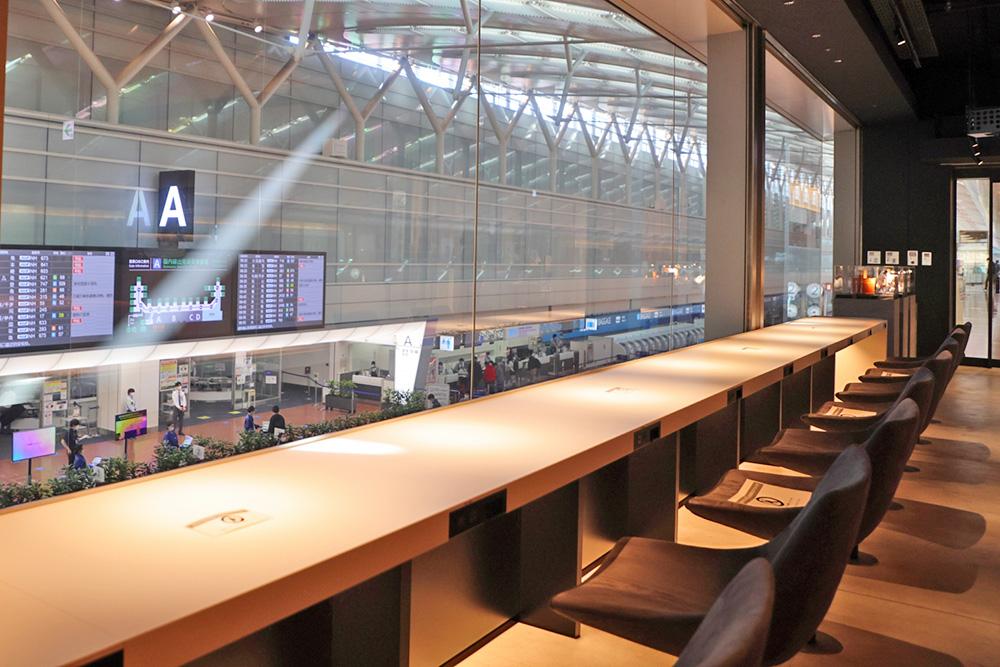
Haneda Airport offers a variety of lounges where you can unwind, enjoy refreshments, catch up on work, or even take a shower between flights. However, lounge access and location vary by terminal—so a little planning goes a long way.
Terminal 3
All lounges in Terminal 3 are located inside the transit area, near the departure gates. If you exit the security zone and go through immigration, you won’t be able to re-enter to use these lounges, so plan accordingly.
Available lounges include: TIAT LOUNGE (4th floor), SKY LOUNGE (4th floor), and SKY LOUNGE SOUTH (3rd floor).
Some lounges offer shower facilities, ideal for refreshing during a long transit.
Terminal 2
• POWER LOUNGE CENTRAL: Outside security on the 3rd floor of the departure lobby — accessible even after arrival.
• POWER LOUNGE NORTH & Airport Lounge (South): Inside the domestic security area.
• POWER LOUNGE PREMIUM: Located inside the international departures area on the 3rd floor.
Terminal 1
• POWER LOUNGE CENTRAL: Located outside security on the 1st floor of the arrival lobby — available after landing.
• POWER LOUNGE NORTH / SOUTH: Located inside security on the 2nd floor.
Lounge access at Haneda Airport varies depending on your airline, travel class, or credit card membership. However, some lounges also offer walk-in access for a fee, meaning you can enjoy their amenities even if you don’t hold a specific card or fly in a premium class. To see full details such as opening hours, eligibility, and available services, it’s best to check the official Haneda Airport lounge page.
Baggage Storage and Coin Lockers
For travelers who need a place to leave their bags temporarily, Haneda provides several practical storage options.
In Terminal 3, coin lockers are available on the second floor near the arrival lobby and in two locations on the third-floor departure level. Locker sizes vary, with small units priced at 400 yen and large units at 600 yen. For exact locker locations and availability, you can refer to the airport’s coin locker information page.
For larger or more valuable items, a staffed baggage storage service is available 24 hours a day. Fees vary depending on the size of the item, and oversized luggage such as skis or surfboards can also be accommodated. This service is also available in Terminals 1 and 2, but note that operating hours in those terminals may be limited. More details can be found on the official page for baggage storage services.
Travelers arriving with pets can also take advantage of pet check-in services. Pet hotels are available in each terminal, offering safe and secure temporary care. These facilities require advance reservations, so it’s important to book ahead of time.
Child and Baby Facilities
Families traveling with young children can take advantage of kid-friendly spaces located throughout the airport.
In Terminal 3, there are two play areas situated inside the security zone. Terminal 2 also has a play space available on the second floor before security, providing a space where children can play and burn off energy before boarding.
In addition to play areas, baby care rooms are available on every floor of all terminals. These rooms are equipped with changing tables, sinks, and nursing booths. While the nursing booths are reserved for mothers, the rest of the space is open to all caregivers, including fathers.
Prayer Rooms
Those wishing to pray or meditate during their time at the airport will find dedicated prayer rooms in both Terminal 2 and Terminal 3. These quiet spaces are designed to accommodate various faiths and provide a calm environment for spiritual practice.
In Terminal 3, there are two prayer rooms located outside the security area. Terminal 2 offers two additional rooms: one before security and one after. No reservations are required, and all prayer rooms are free to use.
More information can be found on the airport’s prayer room information page.
Relaxation Options
If you’re looking to relax during your layover, Haneda Airport offers a variety of massage and wellness services across all terminals. Whether you want a quick refresh or a longer session to unwind, there are several options to consider.
In Terminal 3, Raffine offers full-body massages and reflexology treatments.
This terminal also features refresh rooms inside The Royal Park Hotel Tokyo Haneda, which are open 24 hours and include access to showers. For those staying airside, refresh rooms are also available inside The Royal Park Hotel Tokyo Haneda Transit, located within the secure zone.
Refresh rooms are available starting at 3,000 yen per hour and are limited to one guest per room, offering a quiet space to rest between flights.
Terminals 1 and 2 also offer full-body massage salons, providing additional choices for travelers looking to de-stress.
For a full list of locations and services, visit the official Haneda Airport relaxation page.
Additionally, massage chairs are located throughout the airport. Terminal 3 has them within the security area, while Terminals 1 and 2 have units both before and after security. These chairs can be used for 300 yen per 10 minutes and are a convenient option for a quick break.
To see chair locations and usage details, refer to the official page on massage chairs at Haneda Airport.
Hotels in and around Haneda Airport
Looking for a place to rest during your layover? Haneda Airport and its surrounding areas offer a range of hotel options, from in-terminal stays to nearby accommodations. Here are a few convenient choices.
The Royal Park Hotel Tokyo Haneda
The Royal Park Hotel Tokyo Haneda is located on the 3rd floor departure lobby of the International Terminal. Being directly connected to the International Terminal makes it extremely convenient for stays related to early morning or late-night flights.
View the official website of The Royal Park Hotel Tokyo Haneda.
Villa Fontaine at Haneda Airport(Premier and Grand)
Depending on the room, guests can enjoy views of airplanes taking off and landing, or the nearby river estuary. Additionally, guests can take advantage of discounted rates at the on-site spa facility, Izumi Tenku no Yu.
Villa Fontaine Haneda Airport is a hotel located in Haneda Airport Garden, adjacent to Terminal 3. The complex features two types of affiliated hotels: the high-end “Premier” and the “Grand,” which focuses on convenience and functionality. They have opened in December 2022.
Visit the official website of Villa Fontaine Haneda Airport.
Haneda Excel Hotel Tokyu
Haneda Excel Hotel Tokyu is a hotel directly connected to Terminal 2. The hotel features rooms designed to resemble a cockpit, and from rooms on the runway side, you can watch airplanes take off and land. It’s a hotel perfect for aviation fans and families. Additionally, breakfast is offered in the hotel’s restaurant.
Visit the official website of Haneda Excel Hotel Tokyu.
First Cabin
First Cabin Haneda is located on the 1st floor arrival area of Terminal 1. Unlike typical capsule hotels, this facility offers more spacious accommodations.
Additionally, it features a large communal bath. For short stays, rates start at 2,000 yen for 2 hours.
The amenities are well-stocked, ensuring a comfortable stay. It’s a good option for travelers on a limited budget.
Visit the official website of First Cabin.
Hotel JAL City Haneda Tokyo
Located just a 3-minute walk from Anamori Inari Station, Hotel JAL City Haneda Tokyo also offers a free shuttle bus from Haneda Airport every 30 minutes, making access simple and convenient.
The rooms are relatively spacious and affordably priced, providing good value for travelers looking for comfort without high costs. An added bonus is the nearby Anamori Inari Shrine, a peaceful cultural spot worth visiting if you have some extra time.
Visit the official website of Hotel JAL City Haneda Tokyo.
Cultural Attractions and Entertainment at Haneda Airport
Terminal3: Edo Koji, Haneda Nihonbashi, Festival Plaza and more
Terminal 3, which handles most international flights, offers a variety of cultural and entertainment experiences that go beyond typical airport amenities.
Edo Koji
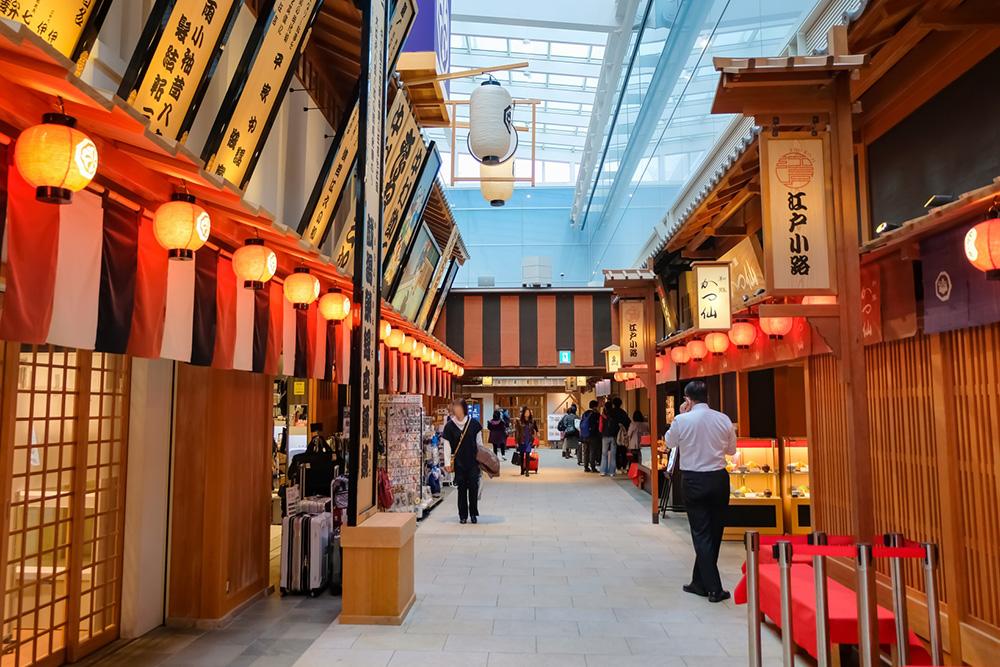
Edo Koji is located on the fourth floor, Edo Koji is a charming area that recreates the ambiance of an Edo-period town. Traditional wooden architecture, built by modern craftsmen using historical techniques, lines the street. Visitors can explore Edo-style buildings, including theaters and storefronts, many of which house functioning shops that blend the historical setting with modern conveniences.
Haneda Nihonbashi
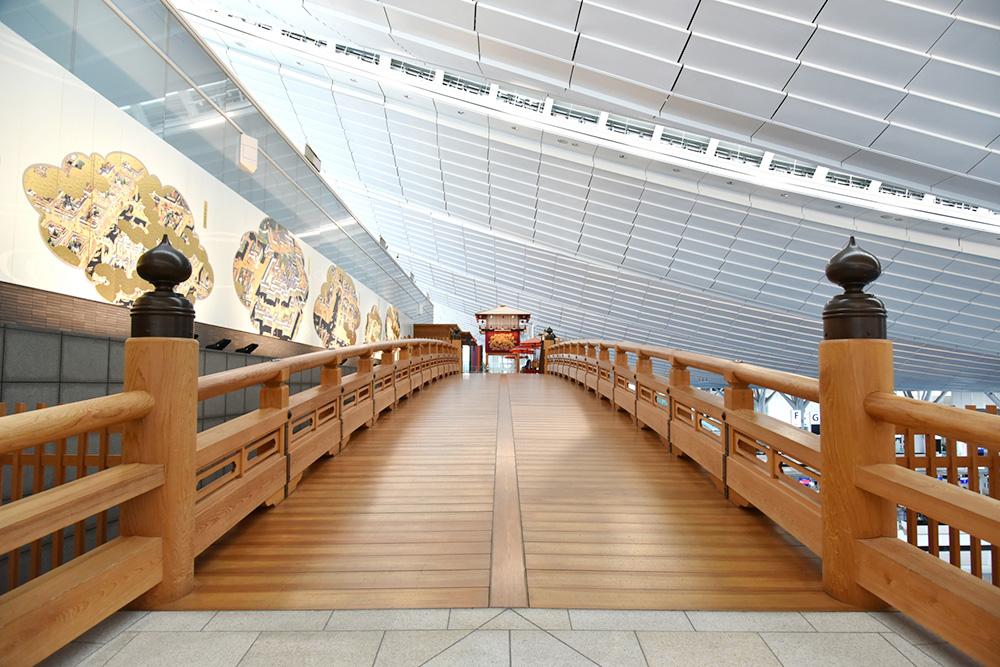
This symbolic bridge is modeled after Tokyo’s original Nihonbashi and constructed entirely from Yoshino cypress. Spanning roughly half the size of the historical version, it represents the departure point for travelers during the Edo period and serves today as a cultural and visual landmark within the terminal.
Festival Plaza
Just beyond Haneda Nihonbashi lies Festival Plaza, where visitors can write messages or wishes on wooden tags and hang them for display. The space celebrates the spirit of travel and personal dreams, creating a moment of reflection amid the airport experience.
TIAT SKY ROAD
Next to Festival Plaza, TIAT SKY ROAD features a display of model aircraft representing airlines that operate international flights from Haneda. It’s a visually engaging corridor, perfect for aviation enthusiasts or anyone looking to enjoy a brief pause with a global perspective before boarding.
Terminal1: Flight Simulator Experience
For aviation enthusiasts or those simply curious about piloting an aircraft, Terminal 1 offers a unique experience on the fifth floor within THE HANEDA HOUSE.
This is where you’ll find Luxury Flight, a paid flight simulator facility open to a wide range of visitors—from children and first-timers to aviation hobbyists and even licensed pilots.
The simulators provide realistic cockpit controls and visuals, allowing guests to experience the thrill of flying in a safe and immersive environment. In addition to the flight sessions, original merchandise is available for purchase, making it a fun stop for both serious fans and families alike.
To learn more about simulator types, pricing, and how to book, visit the official Luxury Flight Haneda page.
Observation Decks for City Views and Plane Watching
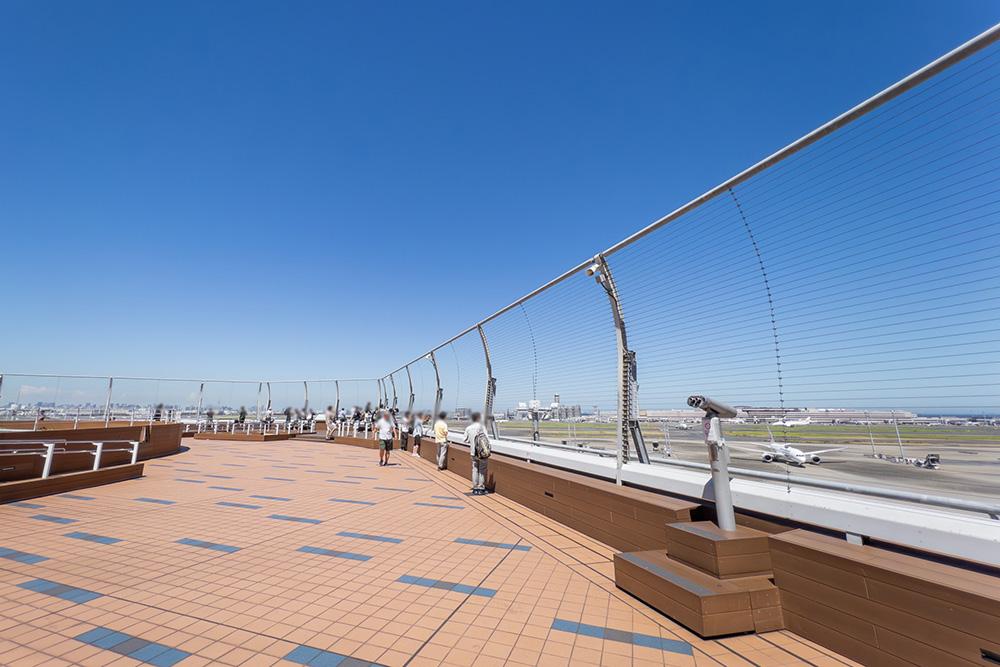
Each terminal at Haneda features an observation deck, offering travelers a chance to relax while watching aircraft take off and land. These decks are great spots for photography, fresh air, or simply enjoying a unique view of the airport and beyond.
Terminal 3’s observation deck is located on the fifth floor and remains open 24 hours a day. On clear days, visitors can even catch glimpses of Tokyo Tower and Tokyo Skytree in the distance, making it a scenic stop for layover travelers.
Terminal 2 offers two different viewing spaces: the open-air observation deck on the fifth floor and an indoor area known as FLIGHT DECK TOKYO, which provides shelter while still delivering great views.
Terminal 1 and Terminal 2 decks are open from 6:30 AM to 10:00 PM daily. All decks offer close-up views of arriving and departing aircraft, creating a memorable experience for aviation fans and casual visitors alike.
Exploring Art Installations
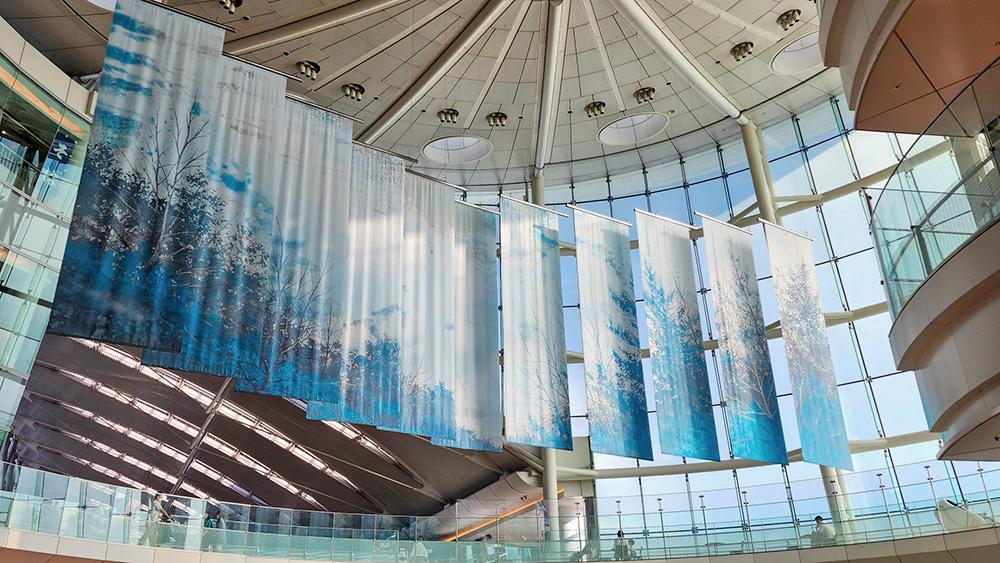
Travelers passing through Haneda can enjoy a range of thoughtfully curated art pieces displayed throughout the airport’s terminals. Several works by renowned Japanese artist Hiroshi Senju are featured across the facility.
In Terminal 3, before reaching immigration, visitors will encounter Water Shrine, a serene piece that welcomes international arrivals. As this artwork is located along the main arrival route, nearly all travelers entering Japan through Terminal 3 will pass by it.
Terminal 2 houses a broader collection of Senju’s works, including Kaze no Keikoku (Wind Valley), GALAXY, MOON, Lakeside in the Morning, and Lakeside in the Evening, each offering a unique atmosphere that complements the terminal’s spacious architecture.
In addition to these installations, the second-floor food court in Terminal 2, known as UPPER DECK TOKYO, features a set of uniquely designed chairs created by architect Takuya Nakamura. Each chair has a different shape and design, turning a simple dining space into a creative showcase worth exploring.
For more insights on where to find art inside the terminals, refer to Haneda’s art and design highlights.
Things to do around Haneda Airport
Now you know how to spend time at Haneda Airport during a layover—but want to explore a bit more outside without going too far? Just a short ride by train or monorail takes you to nearby spots where you can relax, shop, or enjoy a quick taste of local culture before your next flight.
Haneda Airport Garden
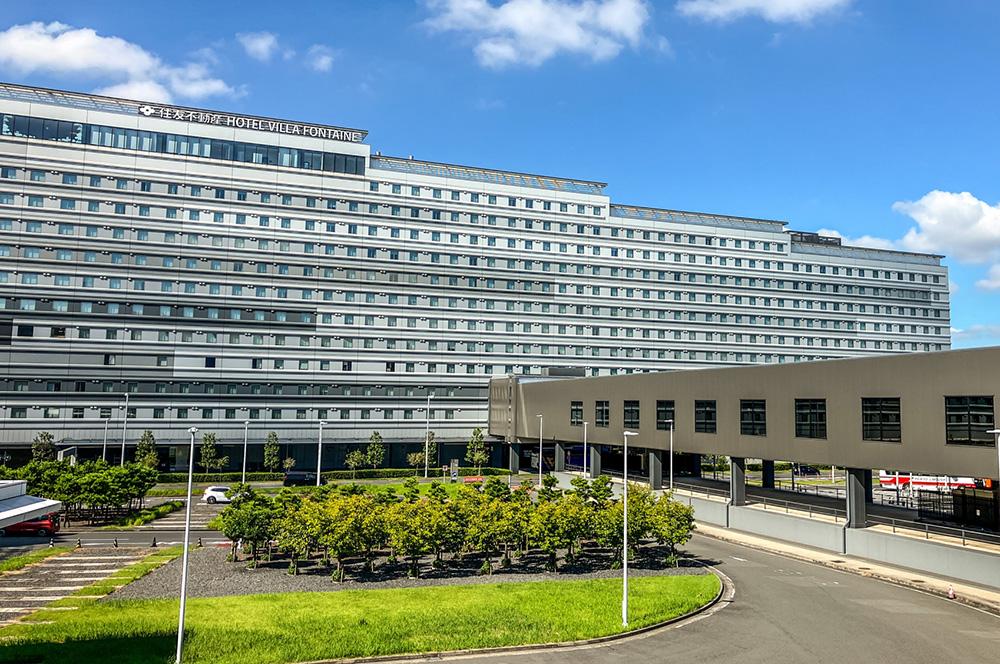
Step away from the busy airport atmosphere and explore Haneda Airport Garden, a multi-use complex directly connected to Terminal 3 via a short pedestrian walkway. Conveniently located just outside the terminal, it offers a variety of ways to spend your layover without going far.
The facility includes restaurants, souvenir and lifestyle shops, as well as fashion retailers—making it an ideal spot to dine, browse, or pick up last-minute items before your flight. Whether you’re arriving or in transit, it’s a practical and enjoyable place to take a break from your journey.
| Name | Haneda Airport Garden |
| Address | Haneda Airport Garden, 2-7-1 Hanedakuko,Ota City, Tokyo, 144-0041 (Map) |
| Opening Hours | Shopping : 8:00 – 21:00 Restaurant and Cafe : 8:00 – 23:00 |
| Travel Time | 0 minute from Terminal 3, 8 minutes from Terminal 2 and 5 minutes from Terminal 1 by shuttle bus |
| Website | https://www.shopping-sumitomo-rd.com/haneda/shopping |
Izumi Tenku no Yu
Izumi Tenku no Yu is a 24-hour spa facility located in Haneda Airport Garden, which is directly connected to Haneda Airport Terminal 3. The spa offers a variety of services including hot springs, saunas, stone saunas, and dining options.
The cost for adults is 4,800 yen, while children from 4 years old to elementary school age are charged 2,000 yen.
Guests staying at Hotel Villa Fontaine receive a discount: 2,000 yen off for adults and 1,000 yen off for children. Face towels and bath towels are included, and adults also receive loungewear and access to the stone sauna.
Please note that the bathing area is closed for cleaning from 10 a.m. to midday. Additionally, reclining chairs are available, but their number is limited.
| Name | Izumi Tenku no Yu |
| Address | Haneda Airport Garden, 2-7-1 Hanedakuko,Ota City, Tokyo, 144-0041 (Map) |
| Opening Hours | 24 hours *Baths are unavailable from 10:00 am to 1:00 pm due to cleaning. |
| Price | Adult : ¥4,800 Child (Age 4 to 12) : ¥2,000 Late night extra fees for Adult : ¥4,000 Special guest rates for Villa Fontaine Grand Haneda Airport guests Adult : ¥2,000 Child : ¥1,000 |
| Travel Time | 0 minute from Terminal 3, 8 minutes from Terminal 2 and 5 minutes from Terminal 1 by shuttle bus |
| Website | https://www.hvf.jp/eng/hanedaairport-grand/spa/ |
Haneda Innovation City
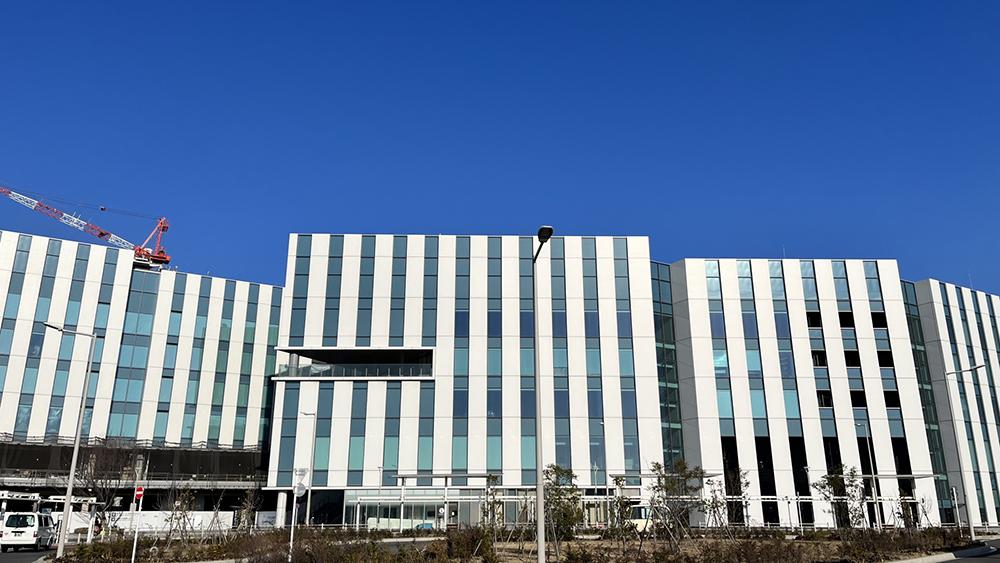
Haneda Innovation City is located just one station away from Haneda Airport Terminal 3, connected to Tenkubashi Station on the Keikyu Line and Tokyo Monorail. It partially opened in 2020 and is set for its grand opening on November 16, 2023.
One of the attractions of this facility is a foot bath spot where visitors can relax while watching airplanes take off and land. Moreover, within the AI_SCAPE area, there is a robot restaurant where robots handle everything from cooking to serving.
| Name | Haneda Innovation City |
| Address | Part of 1 Chome and 2 Chome, Haneda Airport, Ota-ku, Tokyo (Map) |
| Opening Hours | Vary by stores |
| Price | Free |
| Travel Time | 1minute from Terminal 3 and 4 minutes from Terminal 1&2 Take the Keikyu Airport Line (Limited Express) , get off at Tenkubashi Station |
| Website | https://haneda-innovation-city.com/en/ |
Anamori Inari Shrine
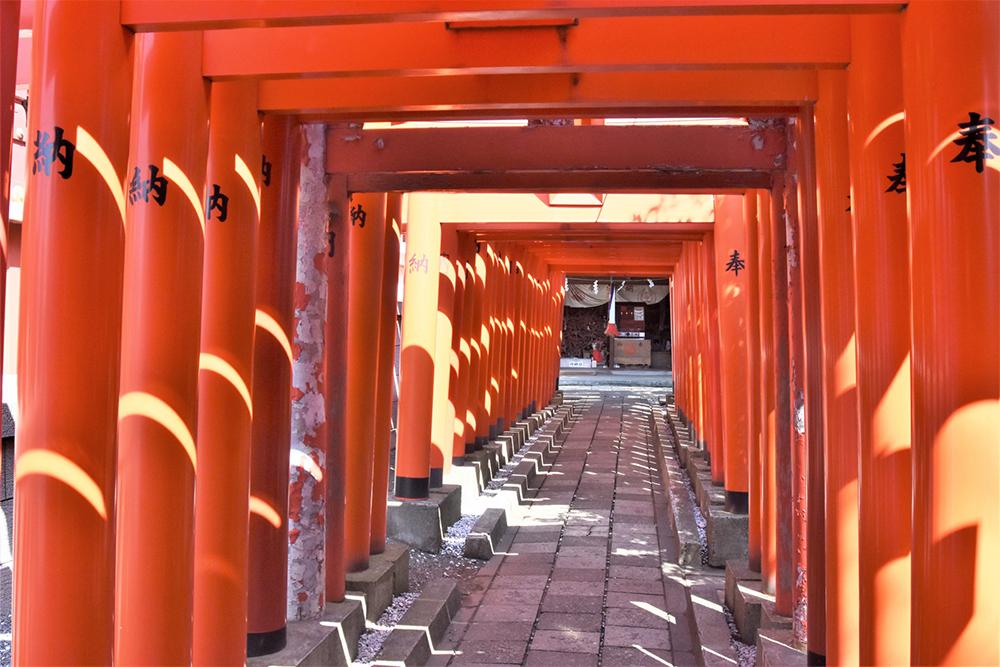
The Anaishi Inari Shrine is renowned for its thousands of torii gates. During the Edo period, the area where Haneda Airport now stands was a tidal flat, which was later reclaimed and developed.
However, due to the constant threat of flooding in this area, a shrine was built for protection.
This shrine was named “Anaishi Inari Daimyojin,” symbolizing the deity that protects the fields from the damages caused by tidal waves.
The shrine flourished, and the donation of red torii gates became a trend. In 1911, an astonishing 46,797 torii gates were dedicated. After the war, the shrine was relocated to its current location. The number of torii gates reduced to around 1,000, but the shrine continues to attract numerous visitors and boasts many torii gates.
Today, it’s also known as a shrine for aviation and travel safety. It’s conveniently located just 6 minutes by car and 12 minutes by train from Haneda Airport.
| Name | Anamori Inari Shrine |
| Address | 5 Chome-2-7 Haneda, Ota City, Tokyo 144-0043 (Map) |
| Opening Hours | 9:00 – 17:00 |
| Price | Free |
| Travel Time | 6 minutes by car, 12 minutes by train from Haneda Airport Take the Keikyu Airport Line (Limited Express) and get off at Anamori Inari station |
| Website | https://anamori.jp |
If you’d like to explore Tokyo comfortably during your layover, Tokyo Travel Assist also offers a customizable Haneda Layover Tour—perfect for making the most of your time between flights.
Jonanjima Seaside Park
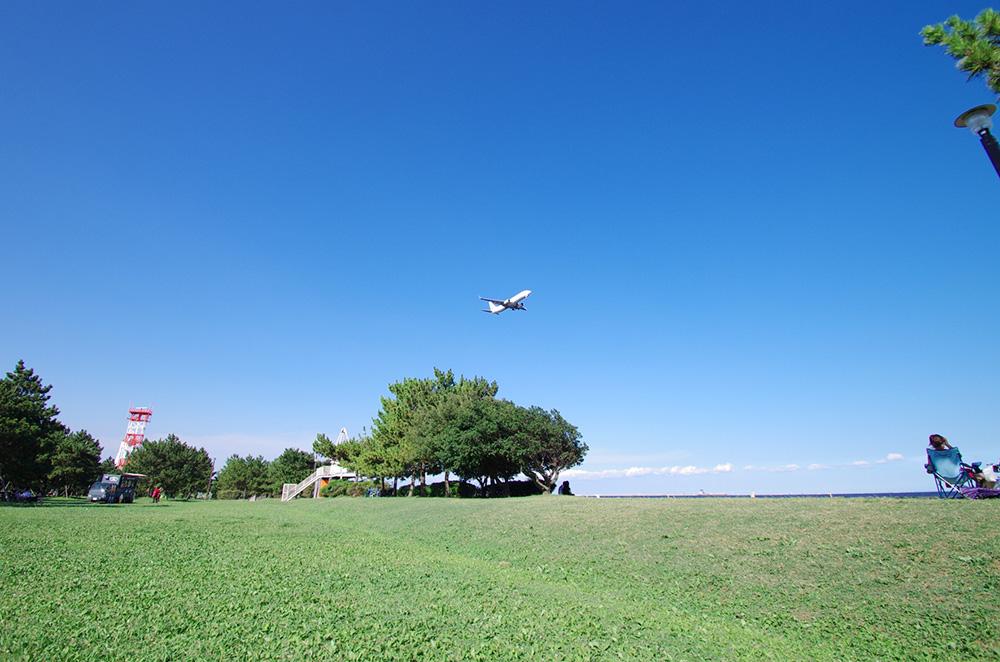
Located directly beneath the flight path of planes arriving at and departing from Haneda Airport, Jonanjima Seaside Park offers an unforgettable plane-watching experience. From the park’s Tsubasa Beach area, visitors can see aircraft flying overhead at strikingly close range, making it a popular spot among aviation enthusiasts and photographers.
Beyond the views, the park features wide grassy fields, a dog run, and open spaces ideal for relaxing or spending time with family and pets. Fishing is allowed along the shoreline, though swimming is prohibited.
Since the park is not easily accessible by train, taking a taxi is recommended. It’s also a good idea to arrange transportation in advance for your return trip, as taxi availability near the park may be limited.
| Name | Jonanjima Seaside Park |
| Address | 4 Chome-2-2 Jonanjima, Ota City, Tokyo 143-0002 (Map) |
| Price | Free |
| Travel Time | 24 minutes by car |
| Website | https://seaside-park.jp/search_park/park_jonan |
Visa-Free and Visa-Required Countries
Normally, a visa is required to pass through immigration and exit the security area, but some countries are exempt from this requirement. As of 2023, there are 70 countries have the right to enter Japan without a visa for short stays.
Visa-Free Entry to Japan
Citizens of the following countries and regions do not need a visa to enter Japan for short-term stays up to 90 days, as long as they do not engage in income-generating activities.
North America: United States, Canada
Asia: Singapore, South Korea, Hong Kong (only for holders of HKSAR passport), Macau (only for holders of MSAR passport), Taiwan (only if the passport includes a personal ID number)
Oceania: Australia, New Zealand
Europe: United Kingdom, Germany, France, Netherlands, Finland, Italy, Belgium, Spain, Poland, Switzerland, Norway, Denmark, Ireland
Latin America: Mexico, Brazil (visa exemption applies only to holders of an IC (e-passport))
For the most up-to-date information and the complete list of visa-exempt countries, please refer to the Exemption of Visa (Short-Term Stay) page on the official website of Japan’s Ministry of Foreign Affairs.
Visa-Required Entry to Japan
Nationals of the following countries must obtain a visa, even for short-term stays in Japan:
China, the Philippines, Vietnam, Russia, Ukraine, Georgia, and CIS countries.
Visa applications must be made at a Japanese embassy or consulate in the applicant’s country of residence.
For travelers from other countries, visa requirements may vary depending on your nationality and visa status in your country of residence. To ensure a smooth entry and avoid issues during your layover, please check the most up-to-date information on the official website of the Ministry of Foreign Affairs of Japan
Even if your country is listed above, or not listed at all, we strongly recommend verifying the visa requirements directly with the Ministry of Foreign Affairs, as rules are subject to change.
If you plan to exit the secure transit area at Haneda Airport during your layover, you will need to go through immigration and customs. Whether this is allowed depends on your visa status.
Make sure to apply for a visa in advance if necessary, so you can enjoy your time in Japan without complications.
Things to Check Before Entering Japan
If you’re planning to leave the airport during a layover in Japan, there are a few important entry and exit procedures you should be aware of to ensure a smooth experience.
Passport and Entry Requirements
Foreign travelers can enter Japan during a layover as long as their passport is valid. Japan does not require a specific number of months remaining on your passport—entry is permitted as long as it is not expired. It’s always best to check your passport validity before traveling.
Streamline Your Arrival with Visit Japan Web
It is highly recommended to use the Visit Japan Web service when entering Japan. This official digital platform allows you to complete key arrival procedures ahead of time, including immigration and customs forms, helping you save time at the airport. By registering before your trip, you can streamline the entry process and avoid paperwork upon arrival. You can sign up early by visiting Visit Japan Web.
No COVID-19 Certificate Required
As of May 2023, Japan no longer requires proof of COVID-19 vaccination or a negative test result to enter the country. This applies to all travelers, including those leaving the airport temporarily during a layover.
Minimum Layover Time for Leaving the Airport
As a general rule, you should have at least 4 to 6 hours of layover time before considering a trip outside the airport. Less than that may leave you rushed or at risk of missing your connecting flight.
Here’s how your time might break down:
- Transportation to and from the city center (often 30–60 minutes each way)
- Time for sightseeing, dining, or resting
- Time to return to the airport, clear immigration, and go through security again
The total time required varies based on the time of day, transportation options, and airport congestion. Always plan with a generous buffer to ensure a smooth return to your gate.
Ticket and Baggage Considerations
When planning to leave the airport during a layover in Japan, be sure to consider how your ticket type and baggage arrangements may affect your flexibility.
If your connecting flights are booked under a single reservation (also called a through-ticket), your checked baggage is usually transferred directly to your final destination. This makes airport procedures smoother, as you won’t need to collect or re-check your luggage.
However, be aware that you won’t be able to access your checked baggage during the layover—even if you need something from it. Be sure to pack all essential items (such as chargers, medication, or extra clothing) in your carry-on bag.
On the other hand, if your flights are booked separately, you may need to claim your baggage after landing and check it in again for your next flight. This process requires more time and reduces how long you can spend outside the airport. Plan to return with enough time for check-in, immigration, and security screening.
Lastly, some low-cost carriers (LCCs) and international airlines may restrict airport exits during layovers based on ticket type or policy. Always confirm with your airline before making outside plans.
Terminal Hours of Haneda Airport
Haneda Airport’s Terminal 3, which operates 24 hours a day, serves most international flights and many low-cost carriers (LCCs), offering greater flexibility for travelers with late-night or early-morning connections.
Terminal 1 and Terminal 2—used primarily for domestic flights—are open daily from 5:00 AM to 12:00 AM.
These terminals close shortly after the final flights depart or arrive, so if you return late at night, re-entry to some areas may not be possible. Terminal 2 also handles a limited number of international flights.
Night and Early Morning Travel Considerations
If you plan to explore Tokyo during a layover, be cautious when going out late at night or early in the morning. Transportation options are limited during these hours, and getting back to the airport can be challenging if you’re not prepared.
Most last trains from central Tokyo to Haneda Airport depart around 11:00 PM, while the first trains resume service around 5:30 AM. If you’re relying on public transportation, check the exact timetable of your route in advance.
Without a plan, you may risk getting stranded and needing to pay for a taxi or other alternative transport.
Travel Insurance and Airline Support
Unexpected delays can happen, even with the best planning. Before your trip, it’s a good idea to check whether your travel insurance covers missed flights, alternative transportation, or emergency accommodation.
This is especially important if you’re planning to leave the airport during a layover, when timing is tight.
Additionally, review your airline’s policies on missed connections—full-service airlines may offer more flexibility than low-cost carriers. Knowing what support is available can make a big difference if things don’t go as planned.
Currency Access and Payment Preparation
While many places in Japan accept credit cards and IC cards (like Suica or PASMO), there are still situations where Japanese yen in cash is needed—such as small restaurants, local shops, or taxis.
It’s a good idea to exchange currency before your trip or confirm that your international debit or credit card works with ATMs in Japan. ATMs that accept foreign cards are commonly found at airports, convenience stores, and post offices.
Staying Connected During Your Layover
Reliable internet access is essential for navigation, translation, and staying in touch. Before arriving in Japan, consider how you will stay connected—whether through a SIM card, eSIM, pocket Wi-Fi, or roaming plan.
SIM cards and eSIMs for short-term travelers are available at the airport and online, but some require advance setup or activation.
Language and Communication Tips
While English is understood in major tourist areas, signage, menus, and communication in more local spots may be only in Japanese. In taxis, small restaurants, or when asking for directions, it’s possible that English won’t be spoken.
Having a translation app ready and knowing a few key Japanese phrases can be helpful. Being prepared for limited English communication will make your layover experience smoother and more enjoyable.
Recommended tour services
There are so many tour services in Tokyo, so it can be hard to filter through all of them to find specific layover tours that accommodate your flight times. While there are only a few, there is still a wide variety of layover tours that service Tokyo’s airports. Pick up the popular tours for you at Haneda.
Haneda layover tours
- Tokyo Travel Assist: Tokyo Travel Assist is a service that provides a variety of tours throughout the Tokyo area. Tokyo Travel Assist’s services are also completely personalizable as they can adjust the itineraries to your schedule and travel needs. You can tell them where you want to go, whether it is a well-known sightseeing spot or a hidden gem. Tokyo Travel Assist is one of the best choices for those who want personal yet professional service. Plus, they have a number of knowledgable English guides who can guide you in a private vehicle or with Tokyo’s public transportation network. Check out Tokyo Travel Assist’s information on the Haneda Layover Tour page.
- Outech’s Haneda Layover Tour: This tour is perfect for those transiting through Haneda Airport. Their tours of Tokyo last 3 hours and bring you to all of Tokyo’s best tourist spots including the famous Tokyo Tower and Ginza. The times for the tours are flexible and you will get your own personal English-speaking guide! Find out more about the Outech’s amazing Haneda Layover Tour.
- Tokyo Private Tour’s Haneda Layover Tour: If you have a layover of 6 or more hours at Haneda, then look no further than Tokyo Private Tour’s Haneda Layover Tour. This completely personal tour will pair you with an English guide who will bring you to some famous Tokyo sights including Tsukiji and Tokyo Tower. You will be driven around in a private vehicle of your choice. For those looking for a completely individualized yet quality experience, then this is the tour for you. Check out Tokyo Private’s Haneda Layover Tour!
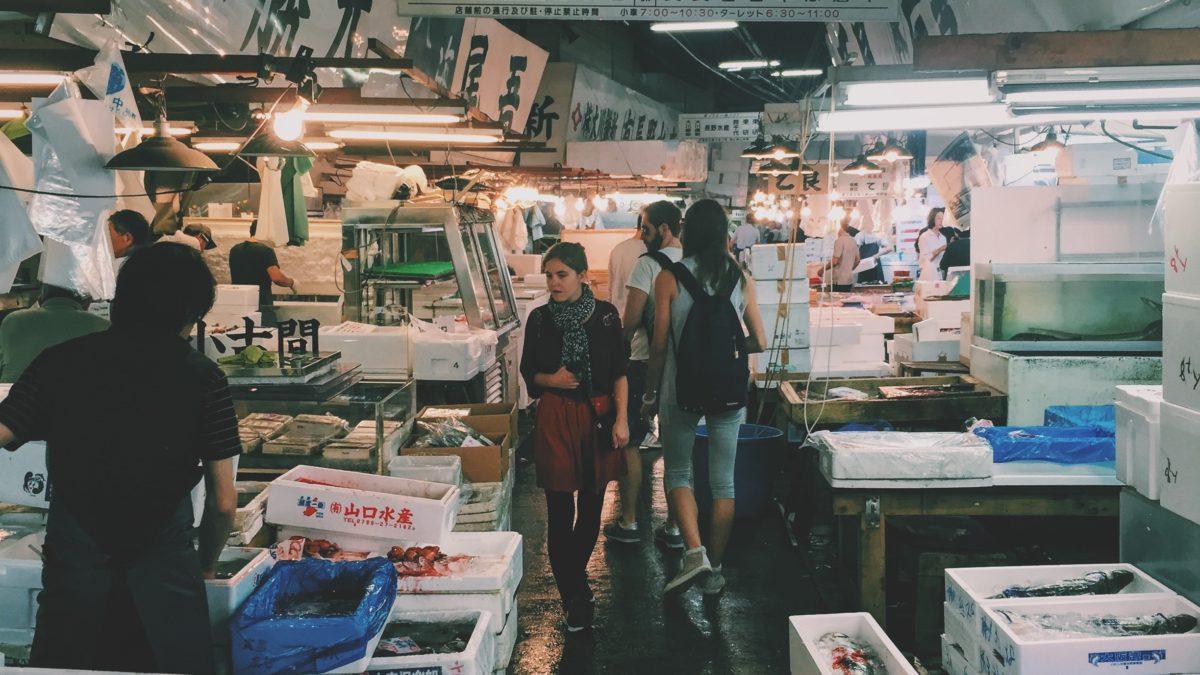
Summary
Haneda Airport and its nearby facilities offer plenty of ways to spend your time during a short layover. From local cuisine and relaxing lounges to cultural spots and convenient services, everything is easily accessible. We hope this guide helps you make the most of your transit experience.



